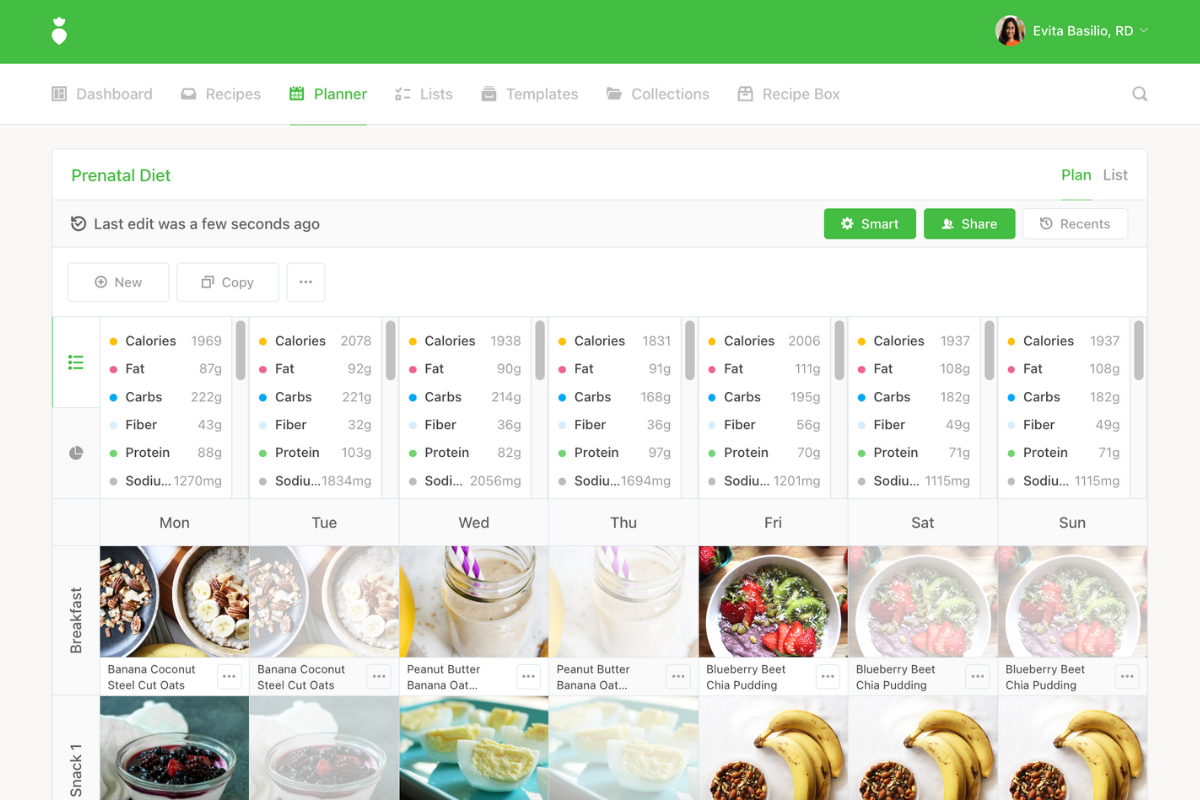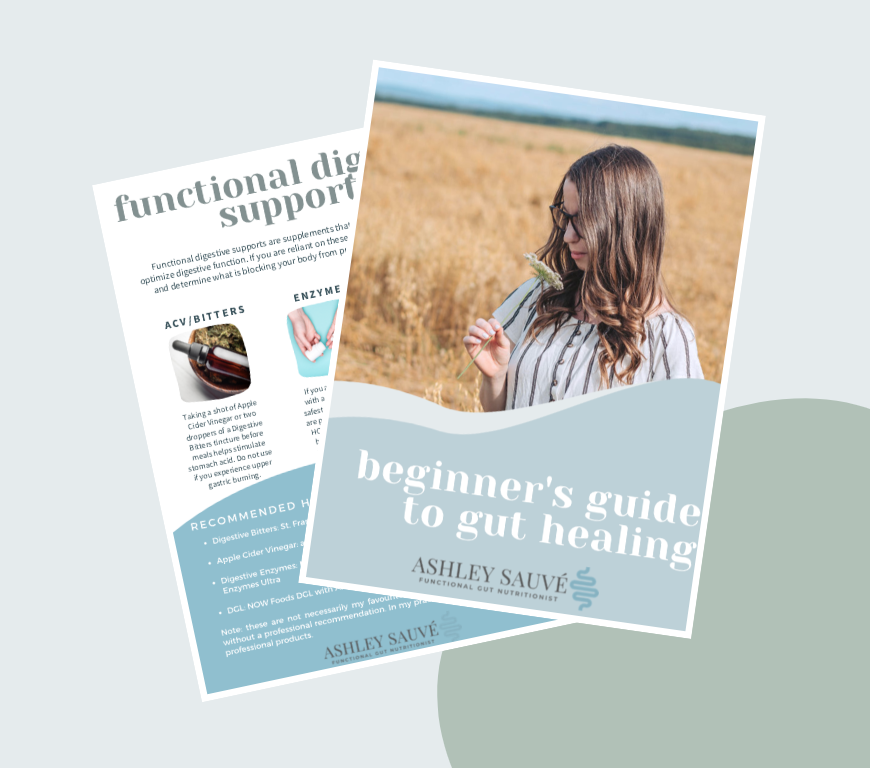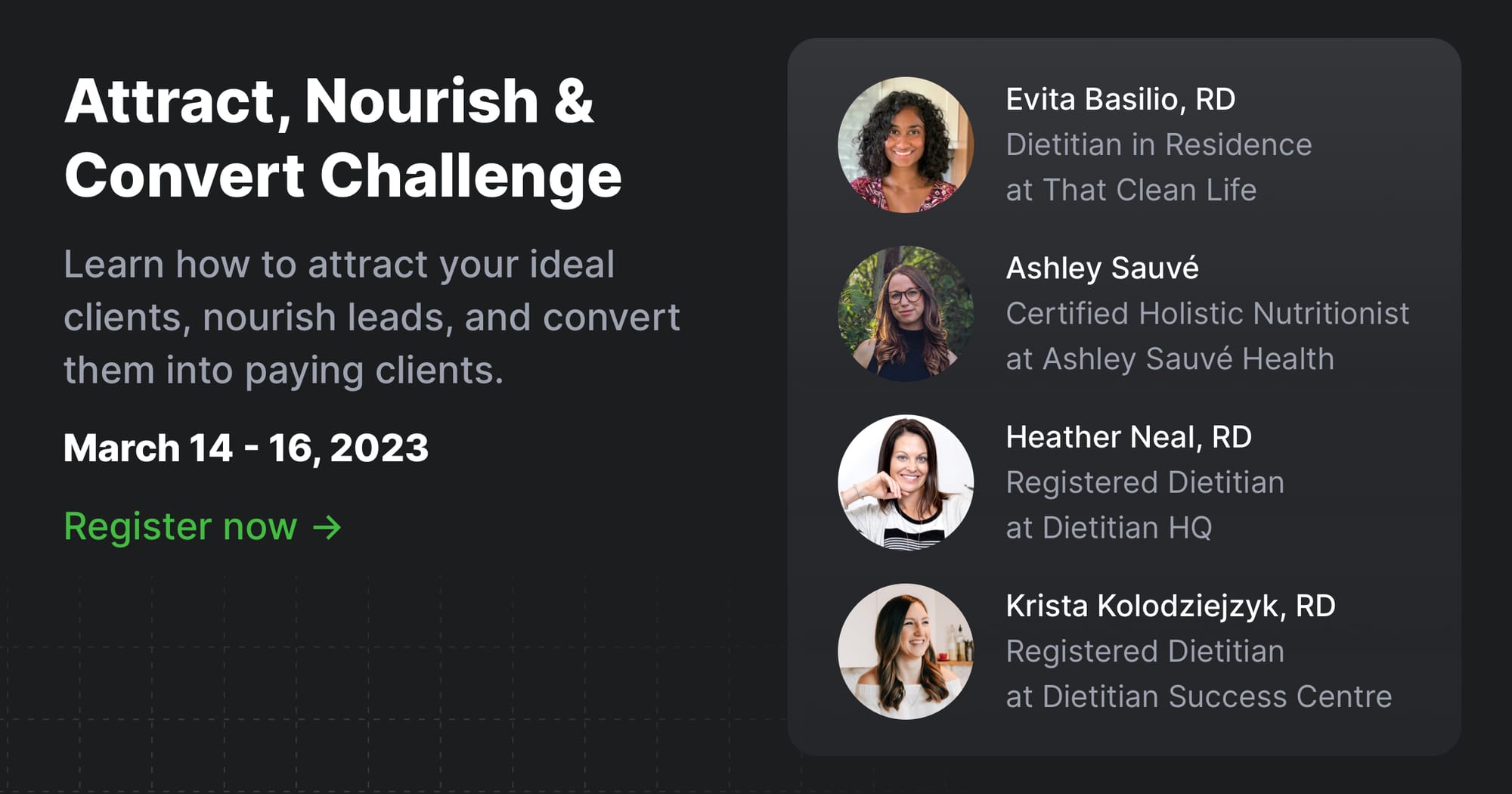As a nutrition professional, you possess a wealth of knowledge and a passion for helping others achieve their health goals. Yet, in a crowded digital world, standing out and connecting with your ideal clients can be challenging.
We met with Clinical Nutritionist and Herbalist Ashley Wulkan to discuss her top strategies for connecting with clients who truly need your services and building a community around your practice.
Ashley supports hundreds of clients worldwide who struggle with gastrointestinal health and runs a clinical mentorship program. She joined our Attract, Nourish & Convert Challenge and shared three steps to attract your ideal clients and grow your email list. Let's dive in.

1. Define your niche
Ashley’s first recommendation is to create a specialization in your practice by defining your niche. She says this is a game-changing decision for your business as clients seek practitioners who specialize in the issue they are dealing with.
“Niching down is actually one of the most important things that you're ever going to do in your business. It means better client care and it also means you will have the capacity to work with more clients and can charge more for your specialized services.”
Early in her career, Ashley worked at a Naturopathic clinic, seeing one-on-one clients, doing recipe development, brand partnerships on social media, teaching workshops, and hosting events. At the same time, she was taking continuing education courses to niche into gastrointestinal health. She started offering group programs and learned that she enjoyed this type of offering. Soon after, she opened her virtual clinic and launched three gut health programs. Ashley has seen amazing growth by reducing her offerings and focusing on making programs the best they can be. Having clear offers and services makes it easy for clients to understand who I help and how I help.
Examples of niches
If you haven't yet chosen your niche, Ashley says there are a few questions to consider:
- What areas of health and nutrition interest you?
- Do you have a personal experience with a specific health concern or area?
- What topics do you find yourself intrigued by or often researching?
- What type of clients do you love working with?
Once you answer these questions, you can narrow down your specialization. Some examples of niches are preconception, pregnancy, and postpartum; working in pediatrics with children who have allergies and digestive issues; autoimmune illness; hormonal health and specializing further within this area like fertility, endometriosis, and PCOS; working with clients who have IBS or IBD; working with fatigue and burnout; or if you love working with older adults, then healthy aging and longevity is a great niche.
Tip: That Clean Life offers a range of done-for-you meal plans on various nutrition topics to jumpstart any client experience with a comprehensive, evidence-based meal plan.

Benefits of choosing a niche
There are several benefits to narrowing down your specialization. For example, you can invest in continuing education within your niche topic to benefit all your clients rather than researching individual cases. Ashley finds if you're working in a specific area, you can justify investing money into an extra course to upgrade your education because it will serve your entire client population and practice. It also means you achieve better results in less time because you more fully understand what you’re doing.
Another benefit is feeling confident clinically because you’re working within your zone of genius.
“Maybe you've already seen a hundred clients before this one who presented the exact same way and you already have a clinical algorithm or a framework that you can work within to get them the results they're looking for in half the time. If you can do that, you are going to feel more confident and more likely to convert that client.”
Other benefits include charging rates based on specializing rather than general practitioner rates and creating effective marketing materials that speak directly to the problem your niche is experiencing and how you can help them.
2. Understand your ideal client
Once you define your niche, the next step is to understand your ideal client to better tailor your offers and programs for optimal client outcomes and produce marketing material that speaks directly to your ideal client and how you can help them.
Ashley recommends understanding your ideal client's demographics and psychographics, like their health concerns, age, and location.
“If you were a fly on the wall in their house, you should be able to really understand what's going on in their day-to-day, what their pain points are, and where you can really step in and make their life better.”
Ashley notes that defining your niche and understanding your ideal client can feel overwhelming. However, it’s important to just start. Your focus might change over time, and that's okay.
“Start with maybe the handful of clients you've worked with so far, make some decisions and then maybe you get one client that changes the game and you realize you love working with moms or you love working with athletes, and then you can tweak as you go.”
3. Create & share a lead magnet
Once you understand who your ideal clients are and their struggles, it’s time to take action to attract these clients.
“This is where you have to step out of your nutrition professional role and into your business owner role, and you get boots on the ground to go out and get these clients. Creating a lead magnet puts it all into practice so you can actually start growing an email list and building this crowd of potential clients that you want to connect with.”
Ashley breaks down a couple of ways to make this pretty easy and help you feel like you're staying in your zone of genius when attracting clients, starting with creating a lead magnet.
What is a lead magnet?
A lead magnet is a resource that you create for your ideal client. It allows them to opt in to receive emails using their email address, which starts to build an email list and gives potential clients a taste of what you can offer.
“This is free and it is one of the first interactions that you are going to have with a potential client. We want to be strategic in what we're creating as for your ideal client this is going to start a relationship with you as somebody who can solve their problem.”
This resource is usually carefully crafted to help them solve a problem they may be experiencing and ideally provide them with a “quick win,” which can be a positive outcome based on what they learn and implement from your lead magnet. A lead magnet should solve a problem they may have but also ultimately relate to the offers you have available in your business.
“We want to provide value, capture emails, nurture our community and build relationships, and make an offer that will help them solve a problem they have. Lead magnets can help build trust, allow prospective clients to get to know you better, how you approach your work and build a relationship with you.”
Examples of lead magnets
You can have fun and experiment with different types of lead magnets. Some examples of lead magnets are:
- Niche-specific meal plan or recipe book
- Downloadable PDF guide (checklist, ‘starter guide,’ roadmap)
- Mini e-course
- List of recommended products to help solve a problem
- Free workshops, webinars, and training, which could be live or pre-recorded
“Create something that you would enjoy downloading, and find valuable. You’ll likely create multiple lead magnets over the lifetime of your business! It’s really important that you stand behind it a hundred percent because this represents what it's like to work with you.”
Ashley’s most successful lead magnet is her 'Beginner's Guide to Gut Healing' created in That Clean Life. This downloadable PDF introduces leads to her approach to gastrointestinal health.
“This has had well over 10,000 downloads. It includes a food guide, an introduction to different types of supplements, and a section on when to seek professional help.”

Tip: Learn How to Create an Awesome Lead Magnet and Use It To Get More Clients
Develop a clear call to action in your lead magnet
You should have a call to action at the end of your lead magnet. This will be based on what you want your ideal client to do once they've downloaded and used your lead magnet.
“Ideally, you’ll be creating a lead magnet with the end goal in mind. Reverse engineer this when you’re brainstorming your lead magnets to ensure it achieves this goal You need to be thinking about WHO your lead magnet is for (your ideal client), and which OFFER(s) you’d ultimately like to invite them into. We are running a business, after all!. Your call to action needs to be the next step for them to take toward that offer.”
Ashley shared great examples of what your call to action can look like.
“You might direct the lead to learn more about your program, book a discovery call and ultimately enroll in your one-on-one program, or direct them to an evergreen webinar, like a pre-recorded training with the goal being to get them to sign up for an online course. The lead magnet could involve signing up for a free community, which is going to be how you promote your program. Or it can go straight into purchasing like a lower-cost offer where you're able to make a sale at the end of your lead magnet without any further nourishing.”
Ashley likes offering a discovery call as her call to action. She uses Practice Better to host her booking page with a custom URL and branded sign-in page. This elevates her client experience, instilling confidence and trust in every interaction.
Advertise your lead magnet
Once you've created your lead magnet, the next step is to share it everywhere you can. The intention is to get it in front of as many of your ideal clients as possible, grow your email list, continue to nurture them, and ultimately welcome them into your offerings.
Ashley recommends sharing your lead magnet on your social media channels like Instagram, TikTok, and Facebook, blog posts, Pinterest, long-form marketing channels like podcasts and YouTube, local businesses like health food stores, and in collaboration with partner practitioners and colleagues.
“You're offering free value so pump this out on whatever channels you're using. Social media has been huge, TikTok and Instagram especially. I've always focused on organic marketing so I've been able to grow my list without paying for any ads. My blog is also a great source of downloads, we link the lead magnet in as many posts as possible to convert readers to the email list.”
Moving your leads onto your email list is vital to building a long-term relationship. The next step is to show up consistently and continue to provide value.
To learn more about nurturing nutrition leads and converting them into clients, check out the next two expert-led talks with dietitians Heather Neal and Krista Kolodziejzyk in our Attract, Nourish & Convert Challenge.

